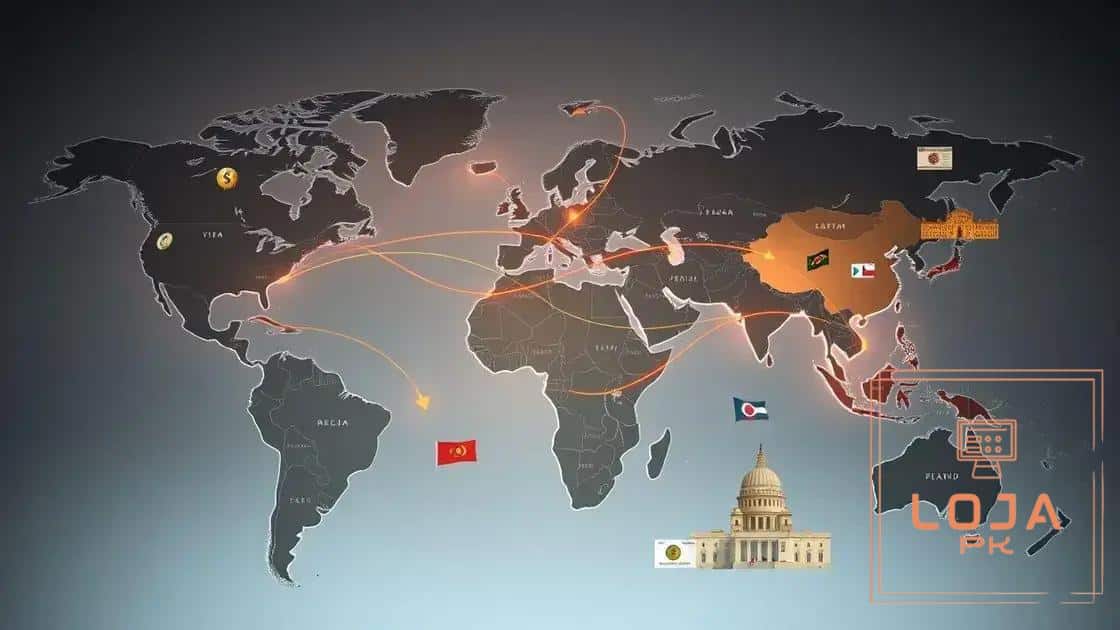Trade policy shifts create uncertainty for exporters

Trade policy shifts create uncertainty for exporters by altering tariffs, market access, and regulations, necessitating adaptable strategies such as diversification and supply chain strengthening to navigate the changing landscape.
Trade policy shifts create uncertainty for exporters, leading to complexities in planning and strategy. Have you noticed how quickly market dynamics can change? Let’s explore these challenges together.
Understanding the impact of trade policy changes
Understanding how trade policy changes can impact exporters is crucial for businesses aiming to thrive in a volatile market. These shifts can affect tariffs, trade agreements, and overall market access, making awareness essential.
Key Effects of Trade Policy Changes
When new trade policies are implemented, exporters may experience several immediate consequences. These can include limitations on exports, increased costs due to tariffs, and altered competitive landscapes.
- Increased tariffs can raise costs for exporters.
- Possible delays in shipping due to new regulations.
- Changes in demand for products based on policy implications.
- Altered relationships with foreign partners.
To navigate these challenges, businesses must stay informed about changes in policies and their implications. Engaging with trade experts can provide insights on adapting strategies effectively. Moreover, flexibility in operations and alignment with legal guidelines can minimize risks associated with shifting trade policies.
Strategies for Coping with Policy Changes
Companies should consider developing contingency plans when anticipating trade policy shifts. Establishing a network of reliable contacts can also be beneficial. Understanding local regulations and their impact is another strategy that can enhance adaptability during uncertain times.
Businesses may also want to assess their supply chains regularly. This assessment helps ensure they can adjust quickly to any new regulations that may arise. Keeping track of international trade relations is essential because they often influence domestic policies and the global market.
Key factors driving trade policy shifts

The key factors driving trade policy shifts are critical for exporters to understand. Many elements influence these changes, impacting how businesses operate internationally.
Economic Factors
Economic conditions often dictate trade policies. When a country faces economic challenges, it may adjust its trade approach to protect local industries. Exporters should monitor these economic trends, as they can indicate future policy changes.
- Inflation rates can affect pricing strategies.
- Recession may lead governments to impose protectionist measures.
- Growth in a specific sector can encourage supportive trade policies.
Additionally, fluctuations in currency values can influence trade dynamics significantly. For instance, a weaker currency may enhance export competitiveness by making goods less expensive abroad.
Political Considerations
Politics play a vital role in shaping trade policies. Changes in government leadership can lead to entirely new trade agendas. Exporters need to stay informed about political developments to anticipate these changes. Legislative decisions often reflect current administration priorities, which can shift rapidly with elections.
The rise of nationalism in some countries has also prompted more protective trade measures. Such trends can disrupt global trade relationships, making it essential for exporters to adapt quickly.
Furthermore, international relations can impact trade policies. Diplomatic ties between countries can facilitate or hinder trade agreements. Exporters should cultivate an understanding of geopolitical events that could affect their businesses.
Strategies for exporters to adapt to uncertainty
In times of uncertainty, it is essential for exporters to have effective strategies to not only survive but thrive. Adapting to changes in trade policies can help businesses remain competitive and resilient.
Diversifying Markets
One of the most effective strategies is to diversify markets. By exploring new regions and countries for their products, exporters can reduce reliance on any single market. This approach helps mitigate risks associated with sudden policy changes in a particular area.
- Research potential new markets based on demand.
- Understand local regulations and compliance requirements.
- Network with local businesses for partnerships.
Additionally, exporters might consider adjusting their product offerings to meet the needs of various markets. This flexibility can lead to greater opportunities and stability.
Strengthening Supply Chains
Another vital strategy is to strengthen supply chains. A robust supply chain can efficiently adapt to changes, ensuring that businesses can respond quickly to new regulations. Companies should assess their supply chain logistics to identify weaknesses and opportunities for improvement.
Building relationships with multiple suppliers can provide backup options if one source becomes unreliable due to policy shifts. Exporters should also consider local suppliers to reduce potential disruptions.
Continuous monitoring of global supply chain trends allows businesses to anticipate changes and adapt proactively. This foresight is key in maintaining a competitive edge.
Utilizing Technology
Exporters should leverage technology to enhance their operations. Digital tools can provide valuable insights into market trends and consumer behavior, helping businesses make informed decisions. Utilizing data analytics can allow for better forecasting and planning in uncertain environments.
Moreover, adopting e-commerce platforms can open up new sales channels. This technology helps exporters reach consumers directly, increasing sales opportunities despite traditional barriers.
Training employees on the latest technologies ensures that businesses remain agile and can quickly adapt to new market demands or policies.
The role of government in trade policy fluctuations

The role of government in trade policy fluctuations is significant. Governments shape trade policies that directly impact exporters and the overall economy. Their decisions can create stability or uncertainty for businesses.
Policy Creation
Governments are responsible for creating and revising trade policies. These policies can open markets, set tariffs, and establish trade agreements. Exporters must stay aware of how these policies change, as they determine the rules of international trade.
- Trade agreements can lower tariffs and encourage exports.
- Tariffs can increase costs and reduce competitiveness.
- Compliance with new regulations is crucial for export success.
When a government changes, so can its trade agenda. New leaders might favor different approaches, depending on their political and economic goals. This shift can lead to rapid adjustments in trade policies that affect all exporters.
International Relations
Additionally, international relations play a big part in how governments form trade policies. Strong diplomatic ties can lead to beneficial trade agreements, while conflicts may result in tariffs or embargoes. Countries that maintain good relations often see smoother trade flows, benefiting their exporters.
Governments monitor global events and public sentiment, which affects trade policies. If citizens prioritize local jobs, governments may impose protective measures to support domestic industries, impacting how exporters do business.
Support for Exporters
To help exporters adapt to changes, governments may provide resources and support. This support might include trade assistance programs and export financing options to reduce risk. Exporters can benefit from resources that help them understand new regulations, market trends, and potential opportunities abroad.
Government-funded workshops and training can equip exporters with the skills necessary to navigate new trade landscapes. By understanding the role of government in trade fluctuations, businesses can better prepare for shifts that may occur.
Real-world examples of exporters facing challenges
Several exporters face challenges that illustrate the impact of trade policy shifts. These real-world examples help to understand how changes can reshape business strategies.
Case Study: Agricultural Exports
In the agricultural sector, farmers exporting crops have encountered difficulties due to changing tariffs. For example, when new tariffs were implemented on imported goods, citrus exporters in Florida saw a decline in demand from overseas markets. This decline affected their profits and required adjustments in pricing and marketing strategies.
- Exporters had to find new markets to compensate for lost sales.
- Some shifted to organic farming to appeal to niche markets abroad.
- Investing in local partnerships helped access alternative distribution channels.
This situation highlights the importance of adaptability for exporters in fluctuating markets.
Technology Sector Challenges
Similarly, technology exporters face unique challenges. A tech company in the U.S. that relied heavily on exports to China was affected by increasing trade tensions. The sudden imposition of tariffs on technology products led to increased costs, forcing the company to rethink its supply chain and pricing models.
The company began exploring production shifts to countries with favorable trade agreements, reducing dependency on any one market. They also invested in research and development to innovate products that may better resist market fluctuations, demonstrating resilience and foresight.
Textile Industry Adaptations
In the textile industry, manufacturers have faced hurdles due to changes in trade agreements. A textile exporter located in Bangladesh found itself struggling as new quotas were established, limiting export volume. To adapt, the company implemented lean manufacturing techniques to increase efficiency and reduce costs.
Additionally, they established new relationships with retailers in different countries, diversifying their customer base. This shift not only mitigated risks associated with trade policy changes but also fostered stronger international partnerships.
FAQ – Frequently Asked Questions About Trade Policy Shifts for Exporters
What are trade policy shifts?
Trade policy shifts refer to changes in regulations, tariffs, and agreements that affect how goods are exported and imported between countries.
How do trade policy changes impact exporters?
These changes can affect costs, market access, and competitive dynamics, requiring exporters to adapt their strategies accordingly.
What strategies can exporters use to manage uncertainty?
Exporters can diversify their markets, strengthen supply chains, and utilize technology to stay competitive in uncertain environments.
Why is government involvement important in trade policies?
Governments shape trade policies that influence market conditions and can provide support to exporters facing challenges due to policy fluctuations.





